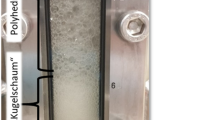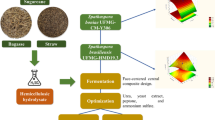Abstract
Whole corn mash fermentations infected with industrially-isolated Brettanomyces yeasts were not affected even when viable Brettanomyces yeasts out-numbered Saccharomyces yeasts tenfold at the onset of fermentation. Therefore, aeration, a parameter that is pivotal to the physiology of Dekkera/Brettanomyces yeasts, was investigated in mixed culture fermentations. Results suggest that aeration strategy plays a significant role in Dekkera/Brettanomyces-mediated inhibition of fuel alcohol fermentations. Although growth of Saccharomyces cerevisiae was not impeded, mixed culture fermentations aerated at rates of ≥20 ml air l−1 mash min−1 showed decreased ethanol yields and an accumulation of acetic acid. The importance of aeration was examined further in combination with organic acid(s). Growth of Saccharomyces occurred more rapidly than growth of Brettanomyces yeasts in all conditions. The combination of 0.075% (w/v) acetic acid and contamination with Brettanomyces TK 1404W did not negatively impact the final ethanol yield under fermentative conditions. Aeration, however, did prove to be detrimental to final ethanol yields. With the inclusion of aeration in the control condition (no organic acid stress) and in each fermentation containing organic acid(s), the final ethanol yields were decreased. It was therefore concluded that aeration strategy is the key parameter in regards to the negative effects observed in fuel alcohol fermentations infected with Dekkera/Brettanomyces yeasts.




Similar content being viewed by others
References
Abbott DA, Ingledew WM (2004) Buffering capacity of whole corn mash alters concentrations of organic acids required to inhibit the growth of Saccharomyces cerevisiae and ethanol production. Biotechnol Lett 26:1313–1316
Abbott DA, Hynes SH, Ingledew WM (2005) Growth rates of Dekkera/Brettanomyces yeasts hinder their ability to compete with Saccharomyces cerevisiae in batch corn mash fermentations. Appl Microbiol Biotechnol 66:641–647 DOI https://doi.org/10.1007/s00253-004-1769-1
Aguilar Uscanga MG, Délia ML, Strehaiano P (2003) Brettanomyces bruxellensis: effect of oxygen on growth and acetic acid production. Appl Microbiol Biotechnol 61:157–162
Barnett JA, Payne RW, Yarrow D (2000) Yeasts: characteristics and identification, 3rd edn. Cambridge University Press, New York
Bayrock D, Ingledew WM (2001) Changes in steady state on introduction of a Lactobacillus contaminant to a continuous culture ethanol fermentation. J Ind Microbiol Biotech 27:39–45
Carrascosa JM, Viguera MD, Núñez de Castro I, Scheffers WA (1981) Metabolism of acetaldehyde and Custers effect in the yeast Brettanomyces abstinens. Antonie van Leeuwenhoek J Microbiol Serol 47:209–215
Ciani M, Ferraro L (1997) Role of oxygen on acetic acid production by Brettanomyces/Dekkera in winemaking. J Sci Food Agric 75:489–495
Ciani M, Maccarelli F, Fatichenti F (2003) Growth and fermentation behaviour of Brettanomyces/Dekkera yeasts under different conditions of aerobiosis. World J Microbiol Biotechnol 19:419–422
Freer SN, Dien B, Matsuda S (2003) Production of acetic acid by Dekkera/Brettanomyces yeasts under conditions of constant pH. World J Microbiol Biotechnol 19:101–105
Freese E, Sheu CW, Galliers E (1973) Function of lipophilic acids as antimicrobial food additives. Nature 241:321–325
Gaunt M, Degn H, Lloyd D (1988) The influence of oxygen and organic hydrogen acceptors on glycolytic carbon dioxide production in Brettanomyces anomalus. Yeast 4:249–255
Gerós H, Azevedo M, Cássio F (2000) Biochemical studies on the production of acetic acid by the yeast Dekkera anomala. Food Technol Biotechnol 38:59–62
Groat M, Ough CS (1977) Effects of insoluble solids added to clarified musts on fermentation rate, wine composition and wine quality. Am J Enol Vitic 29:112–119
Ingledew WM, Burton JD, Hysert DW, Van Gheluwe G (1980) Membrane filtration: survival of brewing microbes on the membrane. J Am Soc Brew Chem 38:25–129
Levine AS, Fellers CR (1940) Action of acetic acid on food spoilage microorganisms. J Bacteriol 39:499–515
Lindgren SE, Dobrogosz WJ (1990) Antagonistic activities of lactic acid bacteria in food and feed fermentations. FEMS Microbiol Rev 87:149–164
de Miniac M (1989) Contamination des fermentations alcooliques industrielles par les levures du genre: Brettanomyces. Ind Agric Alim July/August:559–563
Narendranath NV, Thomas KC, Ingledew WM (2001) Effects of acetic acid and lactic acid on the growth of Saccharomyces cerevisiae in a minimal medium. J Ind Microbiol Biotech 26:171–177
Oura E (1977) Reaction products of yeast fermentations. Process Biochem 12(3):21–35
Phowchinda O, Délia-Dupuy ML, Strehaiano P (1995) Effects of acetic acid on growth and fermentative activity of Saccharomyces cerevisiae. Biotechnol Lett 17:237–242
Scheffers WA (1966) Stimulation of fermentation in yeasts by acetoin and oxygen. Nature 210:533–534
Taherzadeh MJ, Niklasson C, Lidén G (1997) Acetic acid—friend or foe in anaerobic batch conversion of glucose to ethanol by Saccharomyces cerevisiae. Chem Eng Sci 52:2653–2659
Thomas KC, Hynes SH, Ingledew WM (1994) Effects of particulate materials and osmoprotectants on very-high-gravity ethanolic fermentation by Saccharomyces cerevisiae. Appl Environ Microbiol 60:1519–1524
Thomas KC, Hynes SH, Ingledew WM (2001) Effect of lactobacilli on yeast growth, viability and batch and semi-continuous alcoholic fermentation of corn mash. J Appl Microbiol 90:819–828
Van Nedervelde L, Debourg A (1995) Properties of Belgian acid beers and their microflora. II. Biochemical properties of Brettanomyces yeasts. Cerevisiae Belg J Brew Biotechnol 20:43–48
Wijsman MR, Van Dijken JP, Van Kleeff BHA, Scheffers WA (1984) Inhibition of fermentation and growth in batch cultures of the yeast Brettanomyces intermedius upon a shift from aerobic to anaerobic conditions (Custers effect). Antonie van Leeuwenhoek J Microbiol Serol 50:183–192
Acknowledgements
The authors thank NSERC and Alltech for research support and thank the University of Saskatchewan’s graduate scholarship program (to D. A.).
Author information
Authors and Affiliations
Corresponding author
Rights and permissions
About this article
Cite this article
Abbott, D.A., Ingledew, W.M. The importance of aeration strategy in fuel alcohol fermentations contaminated with Dekkera/Brettanomyces yeasts. Appl Microbiol Biotechnol 69, 16–21 (2005). https://doi.org/10.1007/s00253-005-1927-0
Received:
Revised:
Accepted:
Published:
Issue Date:
DOI: https://doi.org/10.1007/s00253-005-1927-0




